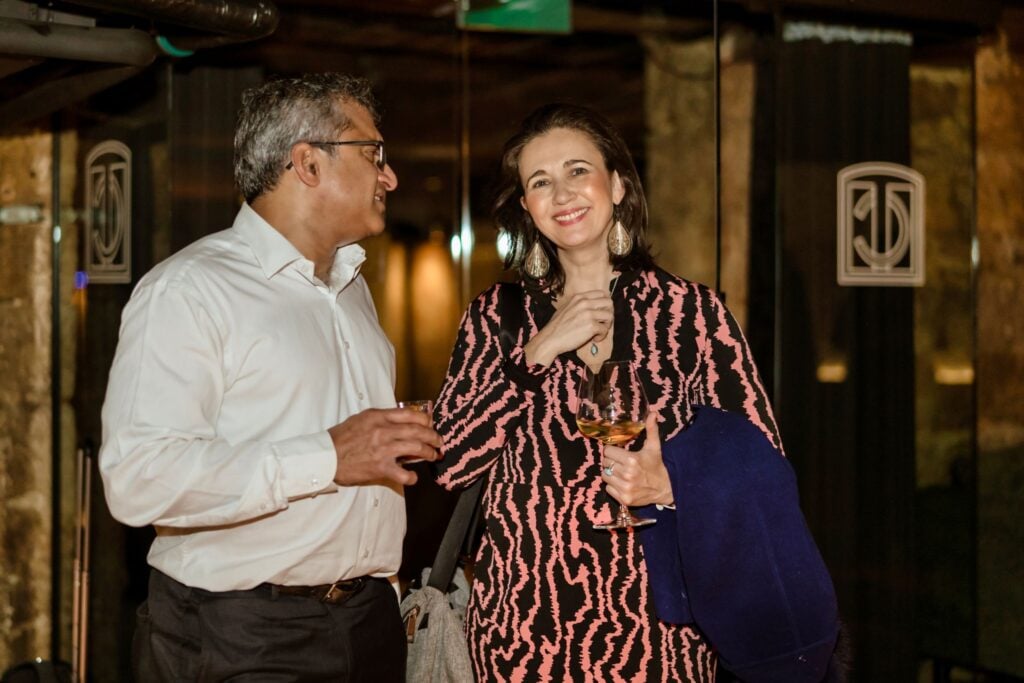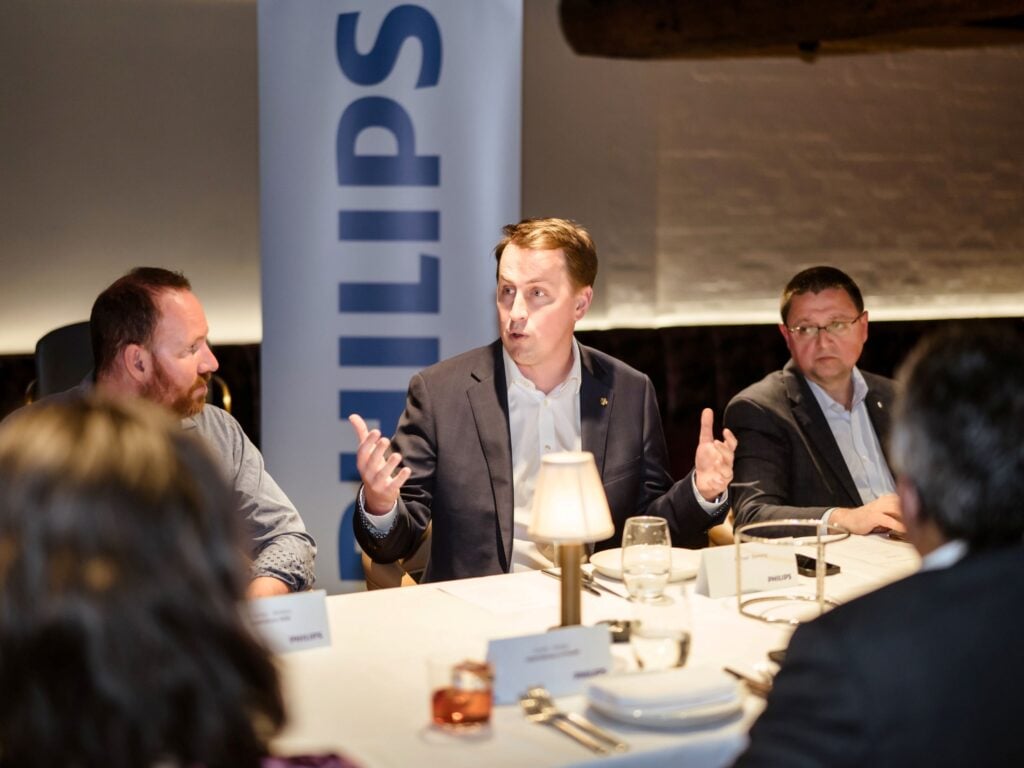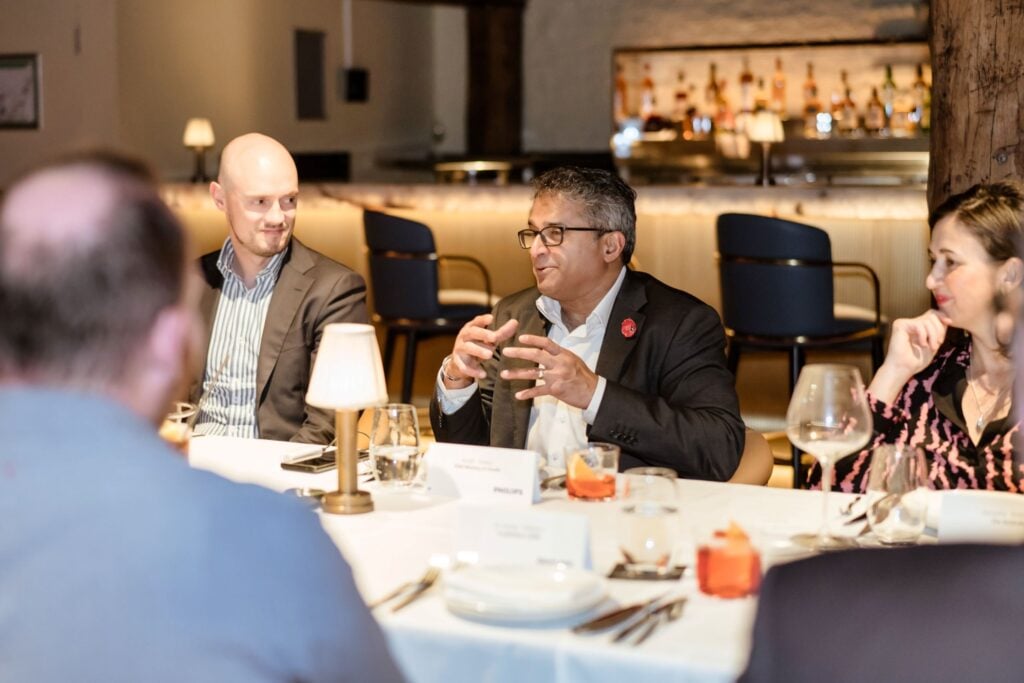Innovating & Evolving: Frameworks for Transforming Healthcare with the Power of AI
Introduction
The Australian healthcare system is navigating a period of unprecedented strain and transformative potential. While faced by critical pressures from workforce shortages to rising patient demands and administrative inefficiencies, AI has emerged as a powerful accelerator to meet these rising healthcare challenges. Healthcare professionals have a unique opportunity to redefine the very nature of care through innovation. The conversation is no longer if AI will play a role in the future of care delivery, but how it can be seamlessly integrated responsibly to forge a more sustainable, equitable, health system for all.
This was the strategic context that drove discussions during the recent executive roundtable dinner hosted by Phillips in partnership with Connect Media. Following the theme of transforming healthcare through the power of AI, the roundtable convened industry leaders to explore the latest strategies, trends and digital innovations for shaping the next era healthcare. Conversations were led by Michael Bonning, Immediate Past President, Australian Medical Association, with exclusive insights from Amith Shetty, Clinical Director, System Sustainability & Performance, NSW Ministry of Health, Scott Bradley, Head of Strategic Business, Public Sector, Government and Public Affairs ANZ, Philips and Helen Callum, Sales Leader Clinical Informatics – Acute / Virtual Care, Philips.

A Healthcare System in Crisis: AI Bridging the Gap
Many healthcare executives see AI as an innovative cost-cutting and efficiency tool, however its impact goes much further – unlocking greater human connection in healthcare. By handling the bureaucratic noise, AI allows clinicians to focus on the most essential elements of care delivery all while forging stronger patient relationships. The primary goal of integrating AI must be the restoration of the authentic human connection in healthcare, beyond the operational and financial benefits.
The current reality sees clinicians drowning in administrative tasks, data entry, and digital documentation, causing patients to face longer waits for specialists and can often leading to poorer health outcomes. These operational hurdles for clinicians naturally erode the therapeutic relationship built with a patient and can also contribute significantly to professional burnout. The transformative power of AI lies in its ability to automate these pressures and repetitive administrative tasks to free up time for quality patient connections. Cultivating this change requires a fundamental shift in design philosophy. Many current digital systems built for data extraction fail to enhance care delivery, inadvertently creating further complexity and additional work for clinicians. By leveraging AI for clinical documentation, data synthesis, and administrative workflow, healthcare can gift its most valuable asset, time, back to its practitioners.
The success of an AI solution should be measured not by how many patients are processed, but by the quality of the interactions it enables. The ultimate vision should be a system where technology facilitates deeper human engagement, without replacing it. Identifying the positive potential impacts of AI however is only the first phase of implementation. Building trust in its implementation across the spectrum of care is essential to finding success.
The Trust Divide Between Clinicians and Patients
While AI continues to advance at an unprecedent rate, public trust lags behind. According to the 2025 Philips Future Health Index report, 85% of Australia’s health clinicians believe in AI’s benefits to healthcare, yet only 43% of patients truly agree. Scepticism remains high and a significant trust gap is growing – from clinician concerns around liability and data integrity, to patient worries about privacy, safety, and the loss of personal connection in care.
For patients, confidence in AI varies across use cases – showing that trust is not always one-size-fits-all. Most patients welcome the use of AI for administrative tasks, however uncertainty grows when integrating it with clinical care delivery. Patients question the credibility of AI’s use for data collection for example when transcribing medical notes, while healthcare professionals’ embrace AI’s role in reducing their workload in this area. But how can leaders communicate the benefits of AI in care without undermining patient trust?
Building the foundation for trust requires a responsible, people-centered approach, one that puts collaboration at the heart of AI innovation. Technology that is developed without the co-design of frontline clinicians, nurses, and allied health professionals, is destined to fail. AI must be anchored in robust safeguards and operate within clear, consistent regulatory frameworks. Leaders must also demonstrate the efficacy and fairness of AI through transparent communication. The Phillips roundtable highlighted that patients are more accepting of AI when it improves and humanises their healthcare experience. In an age where technology has become increasingly embedded in care delivery, these patient fears of a less human healthcare experience are heightened. Only through human-centered design can AI earn the trust it requires to deliver meaningful transformation in healthcare.


From Adoption to Implementation
Australia excels at piloting innovation but often struggles with system-wide implementation. Moving beyond isolated success to forge sustainable systems of the futre requires confronting a series of interconnected challenges spanning technology, governance, and funding.
The most significant barrier is interoperability. The rapid growth of data silos between primary, tertiary, public, and private systems prevents AI from accessing the comprehensive patient data it requires to function at its full potential. Solving this demands a concerted national effort towards standardised data sharing protocols.
Beyond technical hurdles, unresolved accountability and liability concerns create a major adoption barrier. Many healthcare professionals are concerned about liability for AI-assisted clinical decisions. Clear frameworks are needed that define the boundaries of AI’s role and affirm the clinician as the ultimate arbiter of care. This ensures AI is used as a verified support tool, with human oversight, decision making and compassion at the core health delivery.
Approaching implementation strategically and with intention is also vital. AI is also not a monolith. Its implementation must be tailored carefully for the right use case and purpose. In data-rich fields like radiology for example, its role is well-defined. In complex, relational fields like mental health, its value may lie in administrative support rather than supporting with health diagnoses. Understanding where and how AI adds value is key to its appropriate adoption and implementation more broadly from department to department.
Conclusion
The transformation of Australian healthcare through AI is not a near distant future, but a current, ongoing process of discovery. The journey forward requires moving beyond a focus on the capabilities of the technology, to a deliberate strategy for its human-centric implementation.
The true measure of success will not be found in efficiency metrics alone, but in the restoration of the clinician-patient relationship. By strategically deploying AI to shoulder administrative burdens, we can return the focus of care to where it belongs: on empathy, trust, and shared decision-making. This human-centred purpose must be the north star guiding all development and deployment.
Achieving this vision demands a collaborative approach between all stakeholders. It requires co-design with clinicians to build tools that are intuitive and supportive. It demands transparency with patients to build confidence that AI augments, rather than replaces, the human touch in healthcare. It also calls for bold leadership from policymakers and health executives to break down data silos, establish clear accountability frameworks, and create funding models that incentivise value-based, connected care.
The opportunity is not merely to create a more technologically advanced system, but to build a more profoundly human one. By placing people, both patients and providers, at the very center of this transformation, we can ensure that AI fulfills its ultimate promise: a healthcare system that is more compassionate, accessible and resilient for every Australian.
By anchoring this evolution in human experience, building trust through connection, prioritising scalable infrastructure, and navigating ethical challenges with foresight, we can forge a system that is not only more efficient but more compassionate, resilient, and equitable for all Australians.










